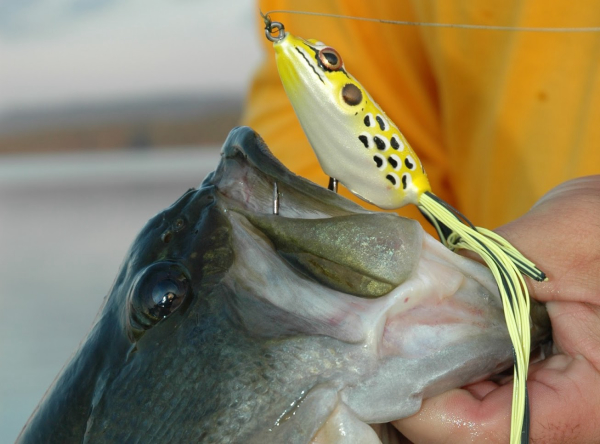
Frog Fish
Time to Get Froggy for Largemouths |
| By Frank Sargeant, Editor from The Fishing Wire With the first day of fall officially proclaimed for Monday, Sept. 23, it’s time to get froggy at lakes across the South.Fishing with weedless frogs has become a “thing” along the weedy shorelines of many lakes since years ago when anglers discovered they could crawl frog imitations across the moss beds, hydrilla tops and lily pads and lure big bass up through the cover to eat the imitation amphibians. The tactic works pretty much anywhere there are largemouths and a lot of surface cover—the spread of hydrilla throughout Florida, for example, has created near endless froggin’ opportunities in the Sunshine State.The specialized lures are a big part of the presentation. They have frog-like bodies of soft hollow plastic, with a double hook that rides on either side of the body, barbs up. The idea is that the hook arrangement slides across the top of even the gnarliest weeds without snagging, but when a bass grabs the bait, it squeezes the body flat and gets stuck on the hooks.Legs of flexible silicone or rubber trail behind to create a swimming effect when the lure is twitched. It’s primarily a fall tactic for two reasons. First, shorter hours of sunshine and longer nights allow the lakes to cool, making the shallows more comfortable for bass that have spent the summer in deeper water. And secondly, the weeds reach their maximum growth as summer ends and fall begins, often topping out and forming surface mats ideal for froggin’. Anglers who practice the tactic a lot, like Guntersville, Alabama, guide Mike Gerry, who fishes mostly SPRO frogs, say the best areas to fish are over water 2 to 4 feet deep where the weeds and moss have topped out and started to dry, turning the color of browned cheese atop a pizza. This means the mat is thick and has been there a while, so it’s more likely to hold bait—and bass. Other froggin’ fans like Captain Mike Carter, also a Lake Guntersville guide, say that a good weedbed has a distinctive sound. Because there are lots of grass shrimp and other small creatures in the moss, it attracts bluegills, frogs and small baitfish, which make a clicking or popping sound as they suck in the food. These fish, in turn, attract large bass—thus a good bed has a particular sound. There are also sometimes “blow holes” in a good bed where bass have been actively feeding, knocking openings in the otherwise matted surface. Snagproof apparently built the first version of the weedless frog many years back, but now most manufacturers have a frog in their lineup; Strike King has the KVD Sexy Frog, LIVETARGET has the Hollow Body Frog and the new Free-Style Frog, and Booyah has the Pad Crasher. All of them catch fish when conditions are right. Fishing the lures is simple. Gear has to be stout because of the heavy cover—many use 40-to 65-pound test braid and a 7.5 foot medium-heavy baitcasting rig, which will have the power to derrick a large bass and several pounds of weeds to the boat. The frog is thrown across the bed and worked back in a series of short twitches with frequent pauses, particularly when it crosses any areas of open water.The only trick to froggin’ is to avoid setting the hook too soon. When a fish hits, there’s an initial splash that sometimes triggers anglers to instantly strike, but that often pulls the lure away from the fish. It works better to hesitate just a second while the fish chomps down on the soft, realistic feel of the lure, then set the hook. Fights tend to be short in froggin’. Either you get the fish’s head up and hydroplane it across the surface to the boat, or it bogs down in 50 pounds of weeds and you have to trolling motor in after it and put the lip-lock on it.Froggin’ does not work on a consistent basis in most lakes, which is why it’s a niche tactic reserved only for fall in many areas. In fact, even in fall on a good froggin’ lake like Guntersville, Eufaula or Kissimmee, you can go for hours sorting through mossbeds, hydrilla jungles, maiden cane stands and duckweed puddles before you find one where a school of bass is feeding. But when you do it’s one of the more exciting types of bass fishing anywhere and you might pull three or four fish in the five-pound range out of one stretch of cover. The frog bite is on right now through most of the south, and usually continues until the first cold front of November, when the surface weeds start to turn black and north winds break them up, driving the fish back to the depths until they head shoreward again in March to spawn. In Florida, the tactic can work pretty much year around, though there are other, better methods for spring and summer. |